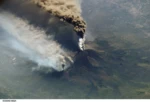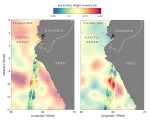
Monday, April 15th, 2024
California’s Death Valley, the driest place in North America, has hosted an ephemeral lake since late 2023. A NASA-led analysis recently calculated water depths in the temporary lake over several weeks in February and March 2024, demonstrating the capabilities of the U.S.-French Surface Water and Ocean Topography (SWOT) satellite, which launched in December 2022. The analysis found

Tuesday, April 2nd, 2024
AccuWeather’s team of expert meteorologists is warning people and businesses to start preparing for a frenzy of tropical activity that could have major impacts on the United States this hurricane season. The AccuWeather 2024 Atlantic Hurricane Season Forecast calls for 20 to 25 named storms. Eight to 12 of those storms are forecast to strengthen into hurricanes. Four to six

Monday, March 18th, 2024
The European Commission (EC) and the European Space Agency (ESA) launched the Earth System Science Initiative to provide a coordinated response to critical environmental challenges and related scientific questions. The EC’s Research and Innovation Department and ESA’s Earth Observation Programmes Directorate are aligning a set of selected scientific activities under their respective Horizon Europe and

Tuesday, March 5th, 2024
New research suggests that sunlight-blocking particles from an extreme eruption would not cool surface temperatures on Earth as severely as previously estimated. Some 74,000 years ago, the Toba volcano in Indonesia exploded with a force 1,000 times more powerful than the 1980 eruption of Mount St. Helens. The mystery is what happened after that—namely, to

Friday, February 16th, 2024
For the second year in a row, farmers in Maryland planted a record amount of winter cover crops in 2016-17. These cold-tolerant crops—including wheat, rye, barley and radish—are planted in the fall. In addition to increasing soil health and boosting yields, cover crops reduce soil erosion and absorb nutrients such as nitrogen that could otherwise affect water quality

Monday, February 5th, 2024
As the world looks for sustainable solutions, a system tapping into NASA satellite data for water management has passed a critical test. Called OpenET, the system uses an ensemble of six satellite-driven models that harness publicly available data from the Landsat program to calculate evapotranspiration (ET)—the movement of water vapor from soil and plant leaves

Tuesday, January 16th, 2024
R-evolution, Hexagon’s sustainable innovation and green-tech investment subsidiary, launched its forest initiative Green Cubes to accelerate biodiversity rainforest conservation worldwide. Using Hexagon’s reality capture technology to accurately measure and visualise the volume and complexity of the rainforest in 3D, R-evolution is enabling corporations to sponsor rainforest segments on a cubic-meter basis. The world’s first Green

Monday, December 18th, 2023
In the heart of California’s Central Valley, a groundbreaking agricultural revolution is underway. Gradient Crop Yield Solutions, a subsidiary of The Morning Star company, is leading the charge in transforming the way tomatoes are grown, using cutting-edge ground sensor technology and remote-sensing analytics to optimize irrigation practices. The satellite imagery provided by EOS Data Analytics

Monday, December 4th, 2023
As part of the long-standing partnership between NASA and Google, NASA worked with Google Arts & Culture and artist Yiyun Kang to create an interactive digital experience around global freshwater resources titled “A Passage of Water.” This immersive experience leverages data from the Gravity Recovery and Climate Experiment (GRACE) satellites and new high-resolution data from

Tuesday, November 21st, 2023
An analysis by NASA’s sea-level change science team finds that if a strong El Niño develops this winter, cities along the western coasts of the Americas could see an increase in the frequency of high-tide flooding that can swamp roads and spill into low-lying buildings. El Niño is a periodic climate phenomenon characterized by higher-than-normal
